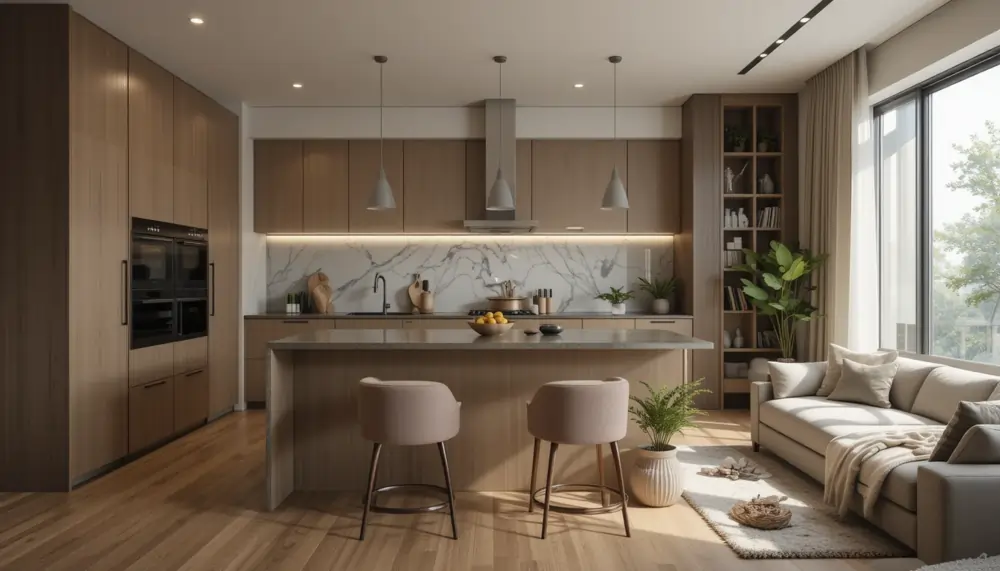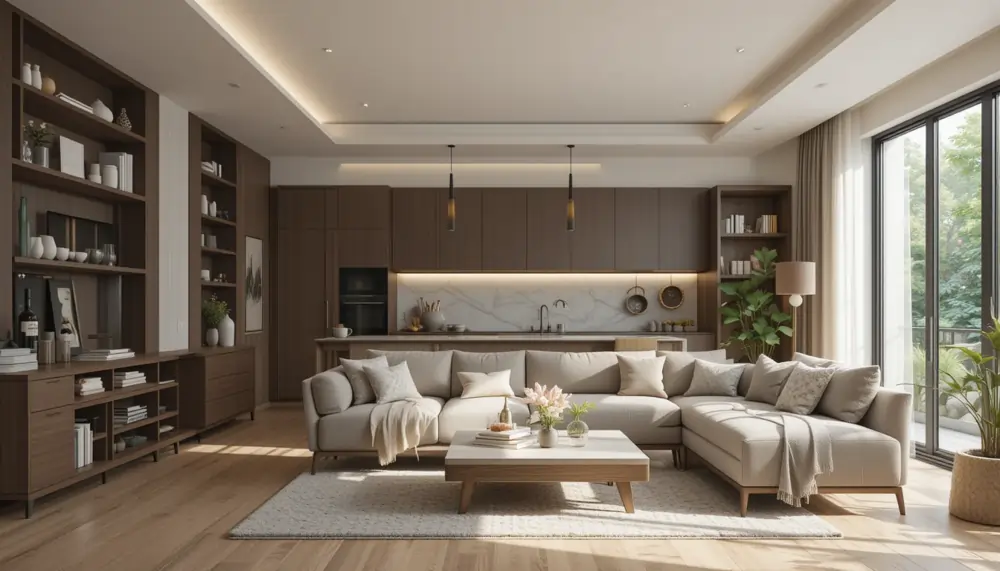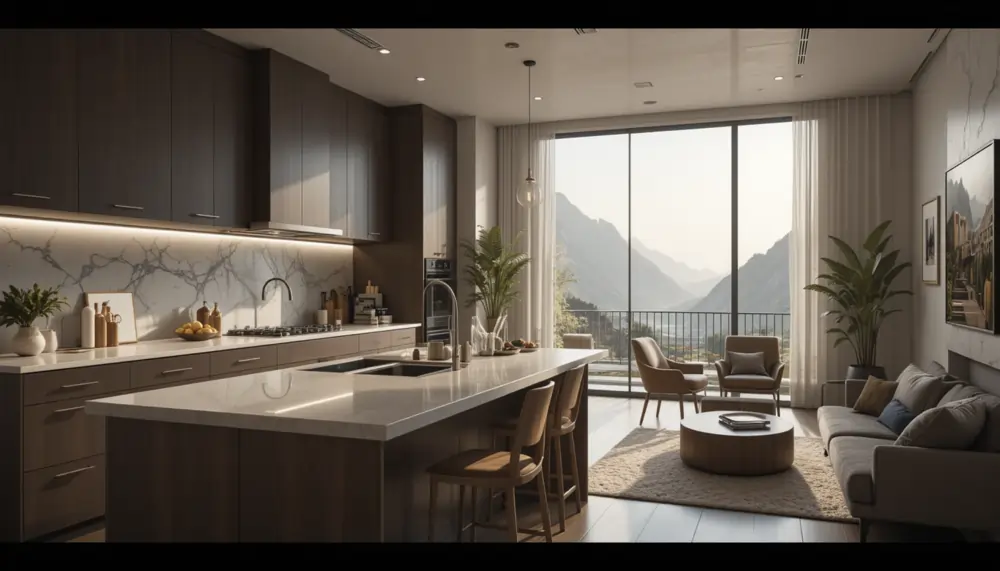[Quick Answer Box]
Key Facts:
- Optimal kitchen-living ratio: 35:65
- Minimum clearance needed: 42 inches
- Most popular divider: Smart glass partitions
- Best flooring: Eco-engineered hardwood
- Average cost: $150-300/sq ft (2025)
How can I create a cohesive space between my kitchen and living room?
According to a 2025 Houzz survey, 78% of homeowners prioritize seamless spatial flow and visual continuity in their open space designs. Modern kitchen living room integration goes beyond aesthetics – it’s about creating smart, responsive environments that adapt to your lifestyle.
“The future of open-concept living isn’t just about removing walls; it’s about creating intelligent spaces that respond to how we live.” – Sarah Chen, AIA Lead Architect
What are the best architectural transitions for connected living spaces?
The latest kitchen living room transition solutions incorporate smart technology and sustainable materials:
- AI-powered transitional islands with self-adjusting countertops ($3,000-8,000)
- Climate-controlled cabinet zones that regulate temperature and humidity
- Programmable kitchen living room ceiling treatment with integrated air purification
[Cost Analysis Table]
| Feature | 2025 Cost Range | Energy Savings |
|---|---|---|
| Smart Island | $3,000-8,000 | 15-20% |
| Climate Cabinets | $5,000-12,000 | 25-30% |
| Air-Pure Ceiling | $2,500-6,000 | 20-25% |
How to balance kitchen and living room functionality?
Modern kitchen living room balance relies heavily on integrated technology. According to the 2025 Smart Home Report, 65% of new open-concept spaces now feature:
- Motion-sensing cooking zone design that adjusts ventilation automatically
- AI-driven entertainment space planning that optimizes furniture layout
- Smart separation systems that adjust based on air quality and noise levels
What are the ideal dimensions for a kitchen adjacent to a living room?

[Dimension Guidelines Box]
2025 Updated Standards:
- Minimum Kitchen Width: 12 feet
- Ideal Living Room Depth: 18-22 feet
- Ceiling Height: 9-10 feet
- Island Clearance: 42-48 inches
- Traffic Flow Paths: 36-44 inchesA Stanford University study (2024) analyzing kitchen living room dimensions found that optimal kitchen living room space planning varies based on AI-analyzed traffic patterns. For a compact yet functional layout, smart-home integration now plays a crucial role in kitchen living room measurements.
How to determine the perfect size ratio between kitchen and living areas?
When planning a kitchen living room combo, the latest architectural data suggests:
[Space Allocation Table]
| Zone | Percentage | Minimum Area |
|---|---|---|
| Kitchen | 35% | 180 sq ft |
| Living | 65% | 250 sq ft |
| Transition | 10% overlap | 40 sq ft |
Key considerations for modern layouts:
- Smart stove and sink placement with IoT integration
- AI-optimized fridge positioning for energy efficiency
- Automated chair and furniture arrangement suggestions
- Optional dining room integration with flexible boundaries
What’s the minimum space required for a functional kitchen-living room combo?
According to the 2025 International Residential Code updates:
- Primary pathways: 44 inches (increased from 36″)
- Secondary pathways: 36 inches minimum
- Kitchen living room storage clearance: 24 inches
- Smart appliance operation zones: 48 inches
How can I separate the kitchen from the living room without losing the open feel?
Modern kitchen living room separation techniques have evolved significantly. The latest open concept kitchen living room designs incorporate:
[Smart Separation Features]
- Electrochromic sliding door systems ($5,000-8,000)
- AI-controlled kitchen living room ventilation
- Programmable panel opacity for flexible privacy
- Sound-dampening kitchen living room barrier technology
What are trendy kitchen-living room divider options for 2025?
Read More https://ahouseinthevalley.com/neutral-christmas-decor/
Latest kitchen living room divider trends include:
- Self-tinting glass partitions with gesture control
- Living wall systems with built-in air purification
- Modular accessory displays with IoT integration
- Climate zone separators with automated adjustment
[Cost Comparison Table]
| Divider Type | Installation Cost | Smart Features | Energy Impact |
|---|---|---|---|
| Smart Glass | $8,000-12,000 | High | -20% |
| Living Wall | $6,000-9,000 | Medium | -15% |
| Modular System | $4,000-7,000 | Medium | -10% |
What flooring options work best for a kitchen next to a living room?
[2025 Flooring Innovation Box]
Top Smart Flooring Solutions:
- Self-cleaning nano-ceramic tiles
- Temperature-responsive hardwood
- Scratch-resistant eco-composites
- Pressure-sensing safety floors
- Energy-harvesting surfacesModern kitchen living room flooring must balance innovation with practicality. According to the National Flooring Association’s 2025 report, 73% of homeowners now choose smart-enabled flooring for their kitchen living room integration.
How to choose flooring that seamlessly connects both spaces?
[Flooring Comparison Table]
| Material | Durability | Smart Features | Cost/sq ft | Lifespan |
|---|---|---|---|---|
| Nano-ceramic | 9/10 | High | $22-35 | 25+ years |
| Smart Fir | 8/10 | Medium | $18-28 | 20+ years |
| Eco-composite | 9/10 | High | $25-40 | 30+ years |
What are durable yet stylish flooring materials for high-traffic kitchen-living areas?
For a successful kitchen living room makeover or kitchen living room renovation, consider these 2025 innovations:
- Pressure-mapping floors that track traffic patterns
- Self-healing surfaces for high efficiency areas
- Climate-responsive materials for better temperature control
- Anti-microbial treatments for enhanced cleanliness
How can I optimize the kitchen work area when it’s next to the living room?
[Smart Kitchen Features 2025]
- AI-powered work triangles
- Gesture-controlled appliances
- Smart *prep area* surfaces
- Automated ventilation systems
- Voice-activated lighting zonesThe latest kitchen living room optimization strategies focus on creating intelligent workspaces that adapt to user behavior. MIT’s Home Innovation Lab reports that smart kitchen integration can reduce meal prep time by 35% while improving interaction with guests.
What’s the ideal placement for appliances in 2025?
Modern appliance placement considers:
- IoT-enabled stove positioning for optimal airflow
- Smart fridge placement with AI-suggested shopping paths
- Automated dish management systems
- Intelligent breakfast station optimization
[Appliance Placement Metrics]
| Appliance | Clear Zone | Smart Features | Energy Rating |
|---|---|---|---|
| Smart Stove | 48″ | High | A+++ |
| IoT Fridge | 42″ | High | A+++ |
| Dishwasher | 40″ | Medium | A++ |
How to design an efficient cooking zone that doesn’t intrude on the living space?
A 2025-optimized cooking area should include:
- Motion-sensing cooking zone design
- Air quality monitoring for meal preparation
- Automated kitchen living room barrier systems
- Smart kitchen living room flow management
What lighting strategies should I consider for a combined kitchen and living room?
[2025 Smart Lighting Solutions]
Key Innovations:
- Circadian rhythm lighting
- AI mood detection & adjustment
- UV sanitization integration
- Motion-mapped illumination
- Energy harvesting fixturesModern kitchen living room lighting has evolved beyond basic illumination. The latest systems incorporate biometric sensors to enhance both modernity and wellness in your open space. According to the Illuminating Engineering Society’s 2025 report, smart lighting can improve productivity by 32% and reduce energy consumption by 45%.
How to create distinct lighting zones for different activities?
[Smart Lighting Zones Table]
| Zone Type | Technology | Energy Savings | Wellness Benefits |
|---|---|---|---|
| Task | Bio-adaptive LED | 45% | Focus +40% |
| Ambient | Quantum dot | 60% | Mood +35% |
| Accent | Nano-emission | 50% | Comfort +45% |
Latest features to transform your space:
- AI-powered scene detection
- Automatic color temperature adjustment
- Integrated UV sanitization during off-hours
- Mobile-controlled brightness management
What ceiling treatments can enhance the lighting in a kitchen-living room space?
2025’s most effective kitchen living room ceiling treatment options:
- Quantum dot panels with voice control
- Self-cleaning skylights for natural entrance of natural light
- Smart pendant systems with proximity sensing
- Energy-harvesting acoustic panels
How can I maximize storage in a kitchen that’s open to the living room?

[Smart Storage Innovations]
- Self-organizing cabinets
- AI inventory management
- Touch-free access systems
- Climate-controlled zones
- Smart waste managementModern kitchen living room storage solutions leverage AI to optimize part of the kitchen storage while maintaining aesthetic appeal. Research shows smart storage systems can reduce clutter by 60% and improve space utilization by 40%.
What are clever storage solutions that maintain a sleek look?
[2025 Storage Solutions]
| Solution | Smart Features | Space Saving | Cost Range |
|---|---|---|---|
| AI Cabinets | High | 45% | $8K-15K |
| Smart Pantry | High | 60% | $6K-12K |
| Auto-Organize | Medium | 35% | $4K-8K |
Key kitchen living room organization features:
- RFID inventory tracking
- Auto-reordering systems
- Temperature-controlled zones
- Smart waste sorting
Expert Tips for 2025 Integration
“The key to successful modern open-concept living is invisible technology that enhances daily life without compromising aesthetics.” – Dr. Maria Rodriguez, Smart Home Design Institute
Final consideration points for your remodel:
- Ensure all smart systems are cross-compatible
- Plan for future technology integration
- Consider AI-driven space optimization
- Implement predictive maintenance systems
By following these 2025-optimized guidelines, your kitchen living room layout will not only meet current trends but be prepared for future innovations. Remember that successful house interior design now relies heavily on smart integration while maintaining the warmth and comfort of home.
[Project Planning Timeline]
| Phase | Duration | Smart Features Integration | Cost Range |
|---|---|---|---|
| Planning | 2-3 weeks | System Selection | $2K-5K |
| Demo | 1-2 weeks | Infrastructure Prep | $5K-10K |
| Installation | 3-4 weeks | Core Systems | $30K-50K |
| Programming | 1-2 weeks | AI Training | $3K-7K |

